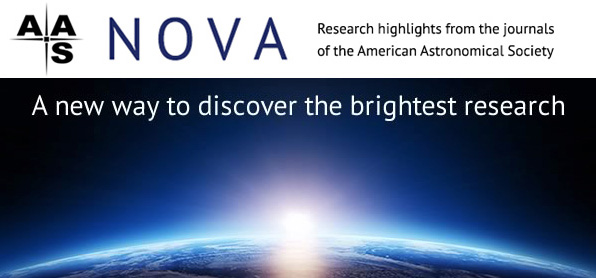Highlights from AAS Nova: 24 December 2017 - 6 January 2018

Susanna Kohler American Astronomical Society (AAS)
AAS Nova provides brief highlights of recently published articles from the AAS journals, i.e., The Astronomical Journal (AJ) and The Astrophysical Journal (ApJ), ApJ Letters, and ApJ Supplements. The website's intent is to gain broader exposure for AAS authors and to provide astronomy researchers and enthusiasts with summaries of recent, interesting research across a wide range of astronomical fields.
The following are the AAS Nova highlights from the past two weeks; follow the links to read more, or visit the AAS Nova webpage for more posts.
5 January 2018
Galaxies Growing Up on the Edge of the Void
How does the absence of galactic neighbors influence galaxy evolution? To answer this question, a new study explores the properties of galaxies in cosmic voids.
3 January 2018
Astrophysics of Red Supergiants
Enormous, cool stars like Betelgeuse can inform studies of stellar evolution, supernovae, gravitational waves, and more! Emily Levesque reveals what we can learn from red supergiants in her new ebook.
2 January 2018
How Fast Is Dark Matter?
Astrobites reports on how we might learn about the speed of nearby dark matter by tracking metal-poor stars.
29 December 2017
Selections from 2017: The Age of a 4-Star System
Astronomers have discovered that an intriguing quadruple star system is younger than was originally thought.
28 December 2017
Selections from 2017: Hubble Survey Explores Distant Galaxies
A catalog of sources has been built using the Cosmic Assembly Near-infrared Deep Extragalactic Legacy Survey (CANDELS), a survey carried out by cameras on board the Hubble Space Telescope.
27 December 2017
Selections from 2017: Discoveries in Titan’s Atmosphere
Negatively charged molecules in the atmosphere of Saturn’s largest moon may help us understand more about how life eventually formed on Earth.
26 December 2017
Selections from 2017: Image Processing with AstroImageJ
Want to process, model, and plot astronomical image data? With AstroImageJ, you don’t need to be a professional astronomer to get started analyzing your own images.


